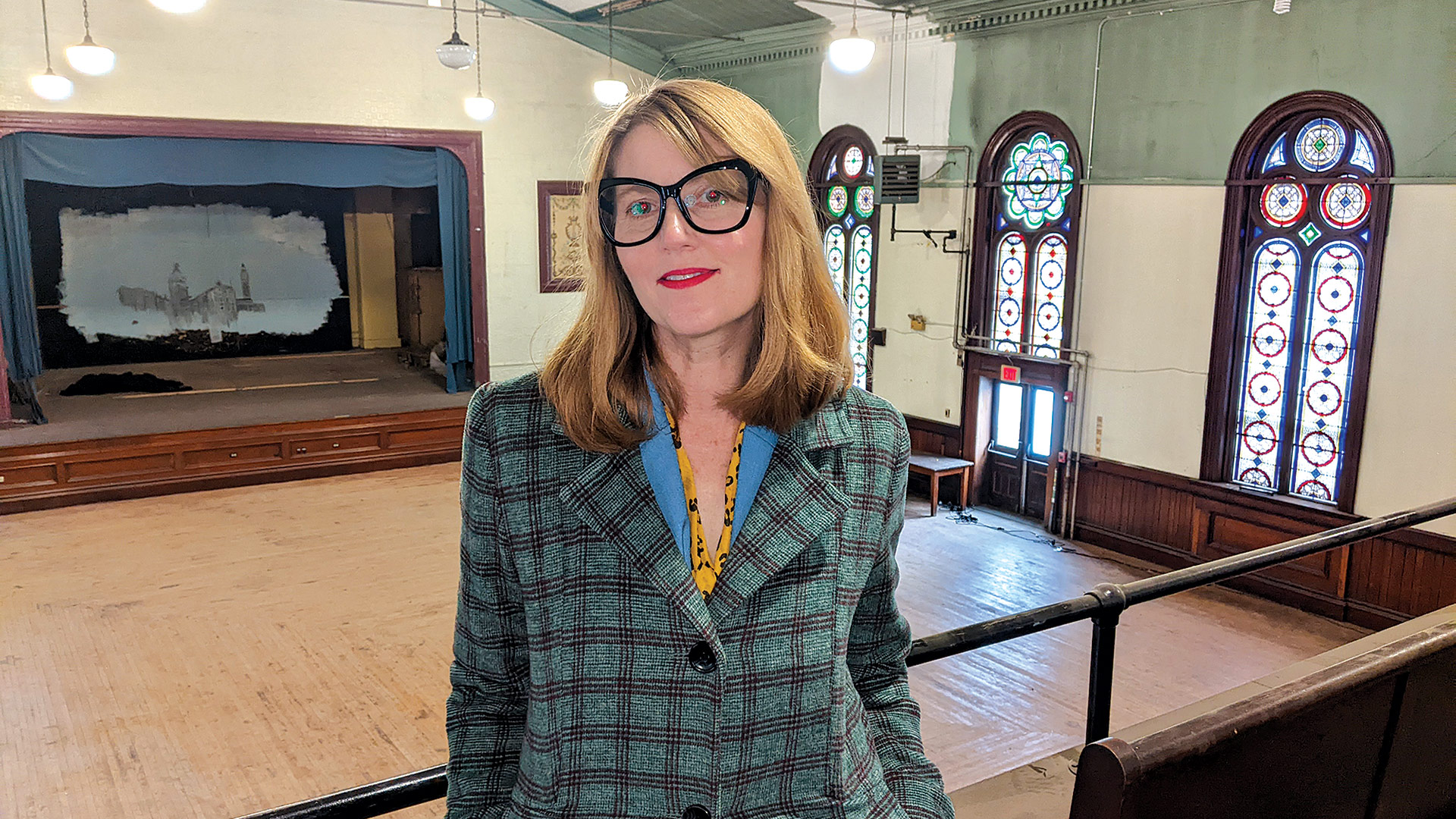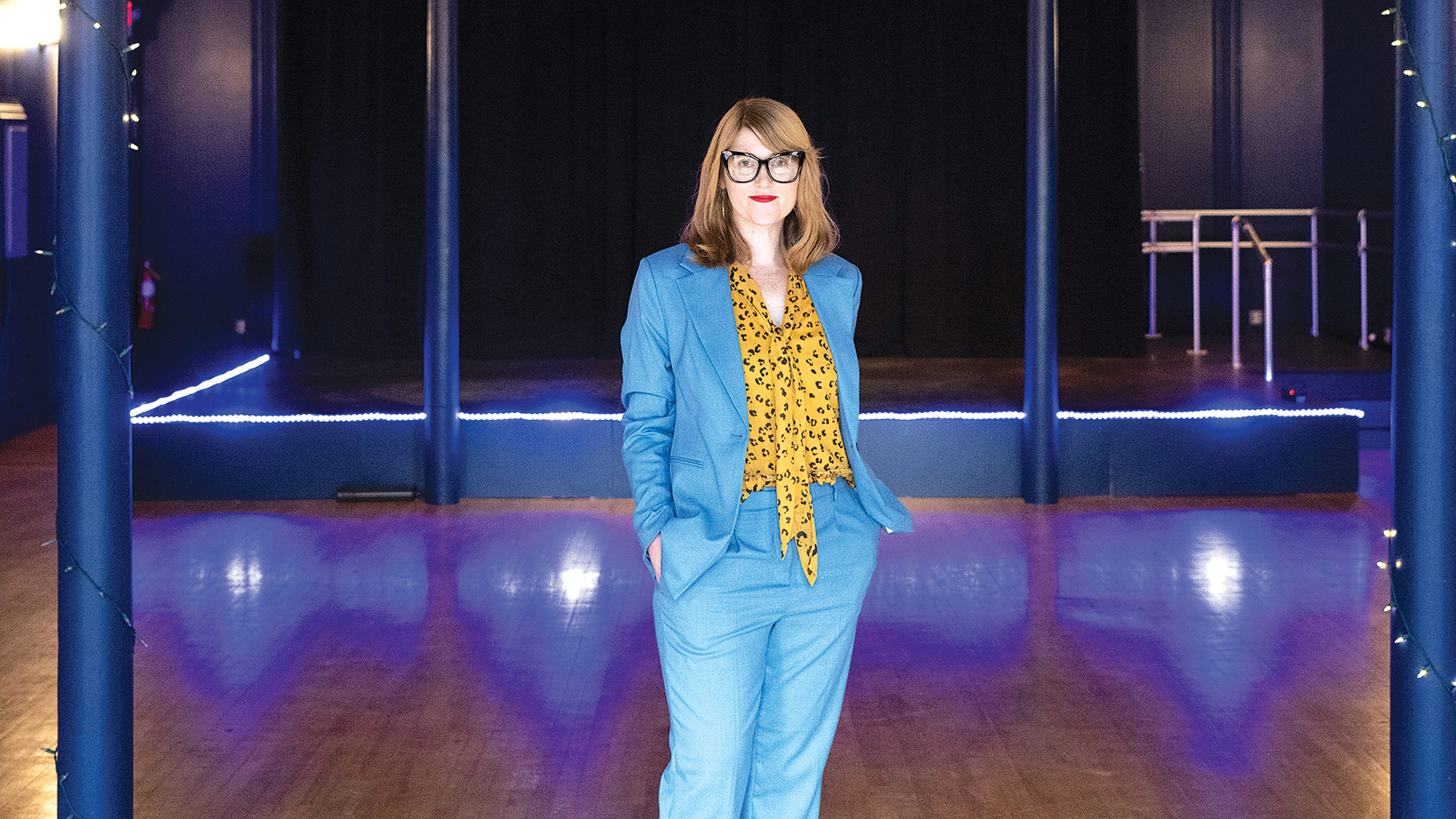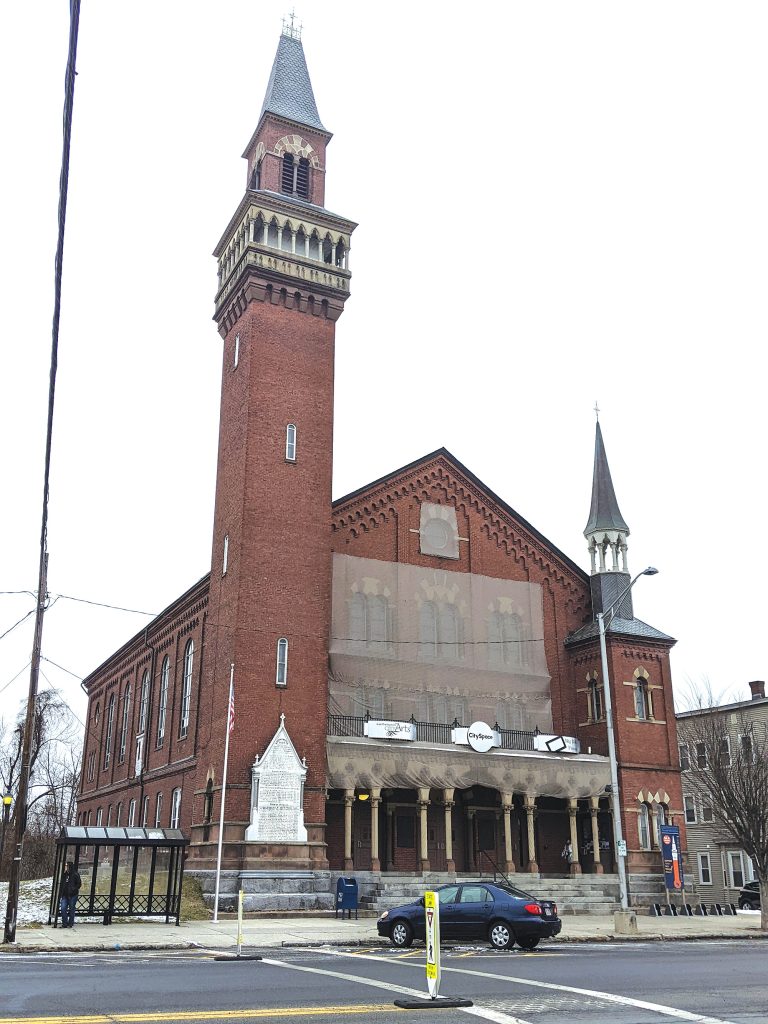
Burns Maxey, Board President, CitySpace
She’s Guiding an Arts Renaissance That Will Reverberate Beyond Easthampton

Burns Maxey
Looking back over two decades in Easthampton, and her current work with a volunteer organization called CitySpace, Carol Abbe Smith saw, in its leader, someone who is making a difference in myriad ways.
“If you came to Easthampton in 2000, you would see empty storefronts and no foot traffic,” said Smith, owner of Delap Real Estate. “Today, Easthampton has restaurants, interesting shops, and music venues, in part due to the vision, energy, and leadership skills of one person: Burns Maxey.”
She’s right, though Maxey is quick to share credit — and share it with a lot of people — for the revitalization of Easthampton’s downtown in the form of an intriguing project to transform Old Town Hall into an arts and performance space, and the ways in which that project has caused, and will continue to generate, economic ripples far beyond the center of town.
“I think artists have the capability of making change happen on a smaller scale and creating reverberations with communities,” Maxey told BusinessWest. “And imagination is the key to thinking outside of the box and really considering what the possibilities are — or beyond the possibilities.”
“I think artists have the capability of making change happen on a smaller scale and creating reverberations with communities.”
Maxey has been heavily involved in Easthampton’s arts culture for the better part of two decades, including serving as arts coordinator for Easthampton City Arts from 2011 to 2016; during her tenure, she oversaw the creation of events like Bear Fest, Cultural Chaos, and the Easthampton Book Fest, securing grants in the process.
Also in 2011, she joined the all-volunteer board of CitySpace, which had been tasked with creating a flexible arts and community space in Old Town Hall, which was built in 1869 and housed the town’s municipal offices until 2003. In 2015, she became board president, and since then, she has helped secure Community Preservation Act funds, multiple foundation grants, and historic tax credits, as well as heading the capital campaign and events committee in an effort to raise about $8.5 million for the project.
Phase one involved renovation of the first floor, including the creation of a small, 80-seat rental performance space called the Blue Room. In conjunction with that, Maxey established a program called Pay It Forward to allow low-income artists the resources, space, and support to create or collaborate on a project, or have a residency to complete a project prior to public performance. After a successful trial in 2022, the program will roll out more fully in 2023, with the help of a $30,000 grant from the Community Foundation of Western Massachusetts.
“This gives access to this space for rehearsals or performances to artists who need it — underserved artists, artists of color, low-income artists, really — anyone who doesn’t have the capacity to pay for the affordable rates we have,” she explained.
It’s also a sort of incubator space, she said. “It’s used for performing-arts groups and everything from community meetings to nonprofit fundraisers to exercise classes and rehearsals. Last year, we had close to 100 events within the space, different populations coming into the building. They get to see what’s happening here and really get to learn about what CitySpace does. So it’s kind of a neat way for us to test some ideas.”

Burns Maxey stands in the Blue Room, which hosted about 100 events in its first year.
Leah Martin Photography
One Pay It Forward recipient, Amherst-based musician Kim Chin-Gibbons, brought her band, Sunset Mission, to CitySpace for a three-day intensive to practice, hone their sound, create a video, and play for a crowd, followed by an audience talk-back session.
“We discovered things about our tech and performances I don’t think we would have for months or maybe years,” Chin-Gibbons said. “It was the perfect place to control all our variables and grow as musicians and people.”
The next phases of the Old Town Hall revival include the restoration of a 350-seat space on the second floor (likely double that capacity for standing-room shows). But that takes fundraising, and Maxey and her board continue that effort, seeing the impact a broadened arts culture has already had on the town’s vitality, and understanding how the completed project will multiply that impact.
“This was established in 1869 to be the hub for community, for performances, for meetings, for dances. It was the place where people gathered.”
“I believe everyone has a place to live and thrive in Western Massachusetts, and now we have a great opportunity to plan smartly to create both affordability and economic flourishing,” she told BusinessWest. “I believe CitySpace is a partial solution to concerns like gentrification by creating long-term affordability to creative space on Main Street, right in the middle of the region.”
By fostering the arts and community she added, “we can make a destination where people want to be, and this, in turn, has economic reverberations. It’s that cycle of reciprocity that will allow this region to fully lift itself up to its potential.”
One Step at a Time
While touring Old Town Hall with BusinessWest, Maxey stopped by Big Red Frame, a business owned by Jean-Pierre Pasche that moved into the building around 2007, a few years after the municipal offices moved out.
“I fell in love with this place 17 years ago when I heard that it was going to be transformed into an arts center,” Pasche said. “I approached the people submitting RFPs to the town, and I said, ‘if you need a tenant on the project, I’ll go in. And I’m still here.”
Maxey credits town officials at the time for having the foresight to envision an arts and culture hub in the building, and recognize the impact that could have on economic development in town.
“I could see the potential for this building,” she added. “And when they showed me the second floor, I was like, ‘oh yeah, I’m really interested in this project.’”

Old Town Hall
The first floor, which includes a number of art spaces and the Blue Room, is largely completed. “When you look at the second floor,” Maxey said, “you see where the funding stopped.”
Elaborating, she explained, “when the pandemic hit, we started to think about phasing the project and what our options would be to continue the work. So we talked to our architects, and they said, ‘yes, you can phase it.’ Initially, we thought that it would be one project as a whole, but it grew from a $6.6 million project to an $8.5 million project, which is a lot, but compared to a lot of other projects within the region and beyond, it’s not too far off from where we originally started.”
Phase two of the project, which has already seen the HVAC system upgraded and modernized, will also add an elevator and newly accessible entryway in front of the building; Maxey said CitySpace needs about $170,000 to get there.
Phase three, easily the most expensive part of the $8.5 million project, will complete the second floor, restoring the ceiling and floors, adding restrooms, installing new electrical and fire-safety systems, and investing in state-of-the-art theatrical and lighting equipment. Amid the modern amenities, Maxey wants to retain as much history as possible, including the mahogany balcony.
“Easthampton, historically, wasn’t a wealthy town,” she explained. “Unlike Holyoke or Springfield or Northampton, we really don’t have a plethora of beautiful buildings throughout the city. This was established in 1869 to be the hub for community, for performances, for meetings, for dances. It was the place where people gathered.”
It’s Maxey’s vision to see that happen again, and she intends to maintain affordable rental rates, not just in the small space currently open, but in the large performance hall on the second floor, once it’s complete.
“That’s part of our mission, to keep this building affordable for arts and community programming,” she said of the Blue Room. “When somebody comes into the space, there’s a flat, hourly rate. But they get everything, like the PA, the projector, tables, chairs. So it’s not like an a la carte menu where we’re adding dollars for each item.”
That model will continue upstairs. “We’re thinking of keeping it very similar to what we’re doing in the Blue Room. It’s a rental space with affordable rates, attracting and really serving artists throughout Western Massachusetts, and we want some traveling artists to come in as well. It’s really a place for people who want to produce events, and it’s also allowing for CitySpace to have our own programming.”
The 350-seat capacity is a “sweet spot” for the area, she added, larger than compact spaces like the Parlor Room in Northampton and the Drake in Amherst, but smaller than the Academy of Music in Northampton, which seats about 800. “Sometimes that’s too much to fill for some artists, and there are a lot of 150-seat locations throughout the region, so this is one step above that.”
CitySpace has a 44-year lease with the city on the building, and Maxey is looking long-term, including applying for Massachusetts historic tax credits after the building is completed, to go toward its continual upkeep.
“Even though we’ll be restoring the second floor,” she said, “we know that having a long-term plan for maintenance on the building will allow it to be here for another 150 years.”
Labor of Love
Maxey, like all the others on her board, serves CitySpace as a volunteer. Meanwhile, her career — which has taken her from Williston Northampton School as communications associate from 2005 to 2011 to her role as Easthampton’s arts coordinator from 2011 to 2016, to the positions of manager, then director, of Digital and Creative Marketing at New England Public Radio from 2016 to 2020 — has entered a new phase with BurnsMax, the art and design business she launched last year. She is also an adjunct professor of Marketing at the Arts Extension Service at UMass Amherst, teaching a class titled “Marketing the Arts.”
In a sense, that’s what she’s doing at CitySpace, too, a role she called “a joy because of the people who surround me.” In doing so, she singled out several other board members, including former Easthampton Mayor Mike Tautznik, Nikki Beck, Peggy Twardowski, and Smith, as well as an artist advisory committee including Trenda Loftin, Emily Ditkovski, Kyle Boatright, Amber Tanudjaja, and Pamela Means, not to mention a capital-campaign team led by Alison Keller and Tara Brewster.
“Seriously, CitySpace is a labor of love,” Maxey said, “and there are so many more that could be named since we are all volunteers right now — me included — as we kickstart this organization into adulthood.”
And pump some energy into the region as well, she added, noting arts organizations and venues opening up from Greenfield to Springfield, all holding the potential of boosting economic development through the arts.
“You can go to all of these locations, and it’s kind of like this renaissance; you see the potential for performing arts to really enliven and connect the whole Western Massachusetts region. And because of that, we have the capability for incredible economic growth within the region — not just a lovey-feely connection, although that exists too.”
Economic development and its many reverberations. The renovation of a historic building. Creating long-term affordability and accessibility for artists. That’s a lot of differences to make, and Maxey and her team are far from done.
“I’ve made my home here, and it’s such a fantastic place to live and work and play,” she said. “And I think we have a lot of potential to make it even better.”




